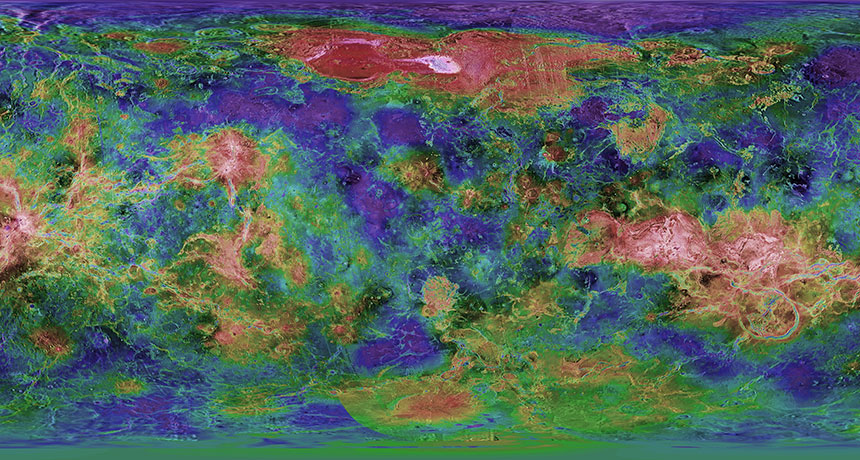Venus may be home to a new kind of tectonics

THE WOODLANDS, Texas — Venus’ crust is broken up into chunks that shuffle, jostle and rotate on a global scale, researchers reported in two talks March 20 at the Lunar and Planetary Science Conference.
New maps of the rocky planet’s surface, based on images taken in the 1990s by NASA’s Magellan spacecraft, show that Venus’ low-lying plains are surrounded by a complex network of ridges and faults. Similar features on Earth correspond to tectonic plates crunching together, sometimes creating mountain ranges, or pulling apart. Even more intriguing, the edges of the Venusian plains show signs of rubbing against each other, also suggesting these blocks of crust have moved, the researchers say.
“This is a new way of looking at the surface of Venus,” says planetary geologist Paul Byrne of North Carolina State University in Raleigh.
Geologists generally thought rocky planets could have only two forms of crust: a stagnant lid as on the moon or Mars — where the whole crust is one continuous piece — or a planet with plate tectonics as on Earth, where the surface is split into giant moving blocks that sink beneath or collide with each other. Venus was thought to have one solid lid (SN: 12/3/11, p. 26).
Instead, those options may be two ends of a spectrum. “Venus may be somewhere in between,” Byrne said. “It’s not plate tectonics, but it ain’t not plate tectonics.”
While Earth’s plates move independently like icebergs, Venus’ blocks jangle together like chaotic sea ice, said planetary scientist Richard Ghail of Imperial College London in a supporting talk.
Ghail showed similar ridges and faults around two specific regions on Venus that resemble continental interiors on Earth, such as the Tarim and Sichuan basins in China. He named the two Venusian plains the Nuwa Campus and Lada Campus. (The Latin word campus translates as a field or plain, especially one bound by a fence, so he thought it was fitting.)
Crustal motion may be possible on Venus because the surface is scorching hot (SN: 3/3/18, p. 14). “Those rocks already have to be kind of gooey” from the high temperatures, Byrne said. That means it wouldn’t take a lot of force to move them. Venus’ interior is also probably still hot, like Earth’s, so convection in the mantle could help push the blocks around.
“It’s a bit of a paradigm shift,” says planetary scientist Lori Glaze of NASA’s Goddard Space Flight Center, who was not involved in the new work. “People have always wanted Venus to be active. We believe it to be active, but being able to identify these features gives us more of a sense that it is.”
The work may have implications for astronomers trying to figure out which Earth-sized planets in other solar systems are habitable (SN: 4/30/16, p. 36). Venus is almost the same size and mass as the Earth. But no known life exists on Venus, where the average surface temperature is 462° Celsius and the atmosphere is acidic. Scientists have long speculated that the planet’s apparent lack of plate tectonics might play a role in making the planet so seemingly uninhabitable.
What’s more, the work also underlines the possibility that planets go through phases of plate tectonics (SN: 6/25/16, p. 8). Venus could have had plate tectonics like Earth 1 billion or 2 billion years ago, according to a simulation presented at the meeting by geophysicist Matthew Weller of the University of Texas at Austin.
“As Venus goes, does that predict where the Earth is going in the relatively near future?” he wondered.